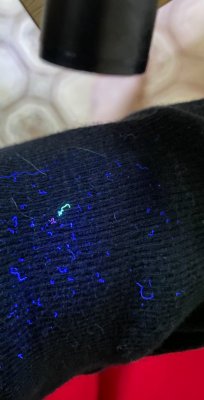- Joined
- Sep 26, 2023
- Messages
- 66
- Purraise
- 185
I hope this is the right place to post this, it is about cleaning, so here it goes haha. Hi everyone! Hope you're enjoying your weekend.
My hubby ordered an UV wand to see if we have any ringworm spores left in the house, and on me too since I got 3 leisures in total when our girl Skye came with her mysterious untreated ringworm. So, the main question is, does anything other than ringworm glows neon green under this light? I sort of notice that on my arm it glows very pale green, and on the surfaces it's more bright and neon like. Can some dust particles show up as green? Little hairs or whirls of fabric?
We did a good clean of the house yesterday with 73% rubbing alcohol, wipes, UV light, vacuuming, and I still find some of this green stuff on the surfaces. I don't want to get paranoid about it.
Our cats are quarantined in my office room. We took all the furniture out and gave them a space to roam. I checked the cats and Skye's hair is growing back and it looks better than before! There is a bit of brown crust on the tips of her ears but no green stuff. Merlin (our little dude) is clean too (well aside from his poopy pants and tail because he gets after potty zoomies).
We took Skye to the vet this week and the lady didn't see anything suspicious but decided to give us a week of itraconazole anyways with the does of 2.5 ml.
And if you have any advice, I'd love to hear it! And excuse my English, sometimes it's ok and at the other times it's slightly off haha
And here is the picture of what I'm asking about

My hubby ordered an UV wand to see if we have any ringworm spores left in the house, and on me too since I got 3 leisures in total when our girl Skye came with her mysterious untreated ringworm. So, the main question is, does anything other than ringworm glows neon green under this light? I sort of notice that on my arm it glows very pale green, and on the surfaces it's more bright and neon like. Can some dust particles show up as green? Little hairs or whirls of fabric?
We did a good clean of the house yesterday with 73% rubbing alcohol, wipes, UV light, vacuuming, and I still find some of this green stuff on the surfaces. I don't want to get paranoid about it.
Our cats are quarantined in my office room. We took all the furniture out and gave them a space to roam. I checked the cats and Skye's hair is growing back and it looks better than before! There is a bit of brown crust on the tips of her ears but no green stuff. Merlin (our little dude) is clean too (well aside from his poopy pants and tail because he gets after potty zoomies).
We took Skye to the vet this week and the lady didn't see anything suspicious but decided to give us a week of itraconazole anyways with the does of 2.5 ml.
And if you have any advice, I'd love to hear it! And excuse my English, sometimes it's ok and at the other times it's slightly off haha
And here is the picture of what I'm asking about

Last edited:




